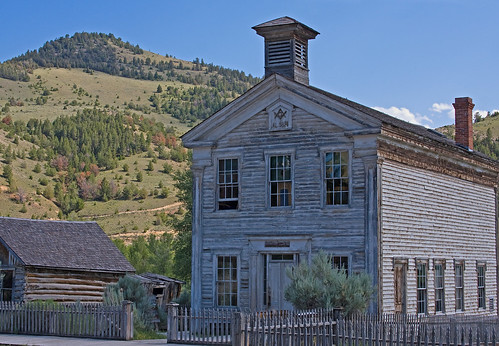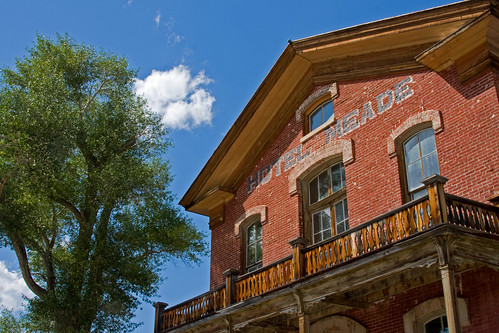On Saturday, I visited Bannack, Montana for Bannack Days in the company of my dad, uncle, son and cousin.
It’s always fun to see the period costumes and events. Dad spent hours visiting with a blacksmith while the rest of us walked around Bannack and took rides in horse drawn carriages.
I was a bit dismayed at how the painted ladies turned the heads of 8 year old boys and the reactions of those boys. Yikes!
Originally built in 1875 to be the Beaverhead County Courthouse, this impressive brick building later became the Meade Hotel.
The county seat was moved to Dillon, MT in 1881 and in 1890 Dr. John Meade purchased the building, remodeled it and converted it into a luxurious hotel.
The hotel was shut down and reopened in cycles that coincided with gold strike booms and busts. It now stands prominent in the ghost town of Bannack, MT.
There has been some recent restoration work completed downstairs and it appeared (when I peeked through a key hole at the prompting of my son) there more is ongoing upstairs. It’s great to see this beautiful old building being cared for.
A remnant of some of Montana’s most colorful history…
BANNACK HISTORIC LODGE NO. 3-7-77

The old Masonic Lodge Hall in Bannack, Montana stands as a memorial to all Masons past, present and future. According to Montana Masonic tradition, when you talk of Montana Vigilantes, this is where it took place, although some non-Masonic historians dispute the level of Masonic involvement. You may visit this lodge in Bannack, Montana, southwest of Dillon. Montana’s first territorial capital, Bannack was the site of the territory’s first major gold strike in 1862 and the cradle of Montana’s government.
Today a quiet ghost town 25 miles southwest of Dillon, Bannack slumbers alongside Grasshopper Creek, once the source of millions of dollars in precious dust. During its heyday, Bannack was terrorized by renegade Sheriff Henry Plummer, whose desperadoes murdered 102 individuals and robbed countless others. Bannack’s law-abiding citizenry rebelled against those atrocities, however. Formation of the “Vigilantes” spelled an end to Plummer’s forays. Twenty-eight of his murderous gang, including Plummer himself, were hanged (a piece of the gallows is on display at the Masonic Museum). Some on a gallows previously built by the outlaw sheriff. The “Toughest Town in the West” then faded as new strikes lured its one-time population of over 3,000 away. Its reputation, however, lives on in Western history and fiction. The remnants of some 60 buildings remain as mute testimony to its rich and oft times violent beginnings.
The old Masonic Lodge Hall in Bannack, Montana stands as a memorial to all Masons past, present and future. You may visit this lodge in Bannack, Montana, southwest of Dillon. Montana’s first territorial capital, Bannack was the site of the territory’s first major gold strike in 1862 and the cradle of Montana’s government.
more>>
http://www.grandlodgemontana.org/Masonry%20in%20Montana/masonry_in_montana.htm
For more (and a different perspective) on the history of Bannack, Montana, the first territorial capital of Montana, the Road Agents gang led by Henry Plummer (criminals) and the vigilante Free Masons who hanged Plummer and his gang, you could start here: www.legendsofamerica.com/MT-Bannack.html

Recent Comments